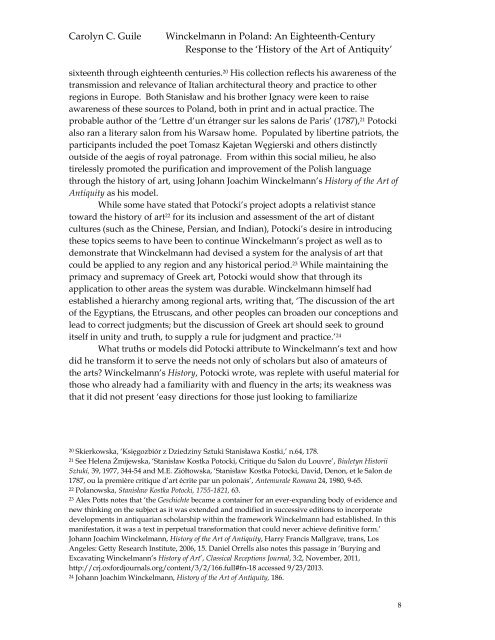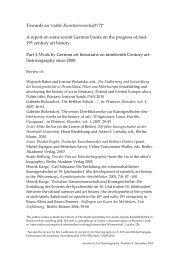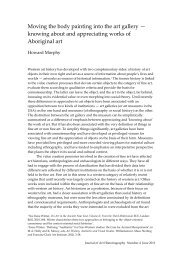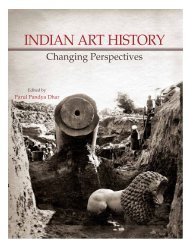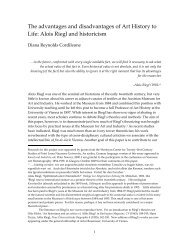9/CCG1 - Journal of Art Historiography
9/CCG1 - Journal of Art Historiography
9/CCG1 - Journal of Art Historiography
Create successful ePaper yourself
Turn your PDF publications into a flip-book with our unique Google optimized e-Paper software.
Carolyn C. Guile<br />
Winckelmann in Poland: An Eighteenth-Century<br />
Response to the ‘History <strong>of</strong> the <strong>Art</strong> <strong>of</strong> Antiquity’<br />
sixteenth through eighteenth centuries. 20 His collection reflects his awareness <strong>of</strong> the<br />
transmission and relevance <strong>of</strong> Italian architectural theory and practice to other<br />
regions in Europe. Both Stanisław and his brother Ignacy were keen to raise<br />
awareness <strong>of</strong> these sources to Poland, both in print and in actual practice. The<br />
probable author <strong>of</strong> the ‘Lettre d’un étranger sur les salons de Paris’ (1787), 21 Potocki<br />
also ran a literary salon from his Warsaw home. Populated by libertine patriots, the<br />
participants included the poet Tomasz Kajetan Węgierski and others distinctly<br />
outside <strong>of</strong> the aegis <strong>of</strong> royal patronage. From within this social milieu, he also<br />
tirelessly promoted the purification and improvement <strong>of</strong> the Polish language<br />
through the history <strong>of</strong> art, using Johann Joachim Winckelmann’s History <strong>of</strong> the <strong>Art</strong> <strong>of</strong><br />
Antiquity as his model.<br />
While some have stated that Potocki’s project adopts a relativist stance<br />
toward the history <strong>of</strong> art 22 for its inclusion and assessment <strong>of</strong> the art <strong>of</strong> distant<br />
cultures (such as the Chinese, Persian, and Indian), Potocki’s desire in introducing<br />
these topics seems to have been to continue Winckelmann’s project as well as to<br />
demonstrate that Winckelmann had devised a system for the analysis <strong>of</strong> art that<br />
could be applied to any region and any historical period. 23 While maintaining the<br />
primacy and supremacy <strong>of</strong> Greek art, Potocki would show that through its<br />
application to other areas the system was durable. Winckelmann himself had<br />
established a hierarchy among regional arts, writing that, ‘The discussion <strong>of</strong> the art<br />
<strong>of</strong> the Egyptians, the Etruscans, and other peoples can broaden our conceptions and<br />
lead to correct judgments; but the discussion <strong>of</strong> Greek art should seek to ground<br />
itself in unity and truth, to supply a rule for judgment and practice.’ 24<br />
What truths or models did Potocki attribute to Winckelmann’s text and how<br />
did he transform it to serve the needs not only <strong>of</strong> scholars but also <strong>of</strong> amateurs <strong>of</strong><br />
the arts? Winckelmann’s History, Potocki wrote, was replete with useful material for<br />
those who already had a familiarity with and fluency in the arts; its weakness was<br />
that it did not present ‘easy directions for those just looking to familiarize<br />
20 Skierkowska, ‘Księgozbiór z Dziedziny Sztuki Stanisława Kostki,’ n.64, 178.<br />
21 See Helena Żmijewska, ‘Stanisław Kostka Potocki, Critique du Salon du Louvre’, Biuletyn Historii<br />
Sztuki, 39, 1977, 344-54 and M.E. Ziółtowska, ‘Stanisław Kostka Potocki, David, Denon, et le Salon de<br />
1787, ou la première critique d’art écrite par un polonais’, Antemurale Romana 24, 1980, 9-65.<br />
22 Polanowska, Stanisław Kostka Potocki, 1755-1821, 63.<br />
23 Alex Potts notes that ‘the Geschichte became a container for an ever-expanding body <strong>of</strong> evidence and<br />
new thinking on the subject as it was extended and modified in successive editions to incorporate<br />
developments in antiquarian scholarship within the framework Winckelmann had established. In this<br />
manifestation, it was a text in perpetual transformation that could never achieve definitive form.’<br />
Johann Joachim Winckelmann, History <strong>of</strong> the <strong>Art</strong> <strong>of</strong> Antiquity, Harry Francis Mallgrave, trans, Los<br />
Angeles: Getty Research Institute, 2006, 15. Daniel Orrells also notes this passage in ‘Burying and<br />
Excavating Winckelmann’s History <strong>of</strong> <strong>Art</strong>’, Classical Receptions <strong>Journal</strong>, 3:2, November, 2011,<br />
http://crj.oxfordjournals.org/content/3/2/166.full#fn-18 accessed 9/23/2013.<br />
24 Johann Joachim Winckelmann, History <strong>of</strong> the <strong>Art</strong> <strong>of</strong> Antiquity, 186.<br />
8


